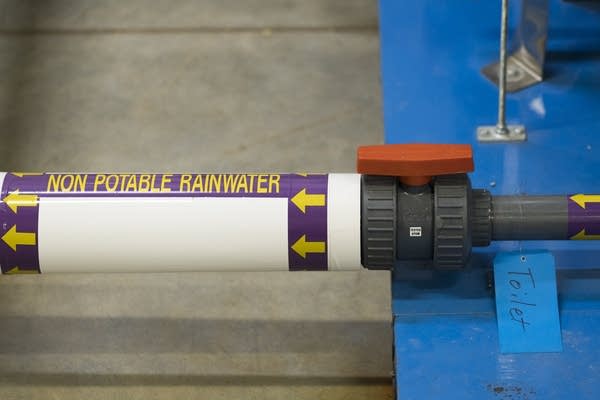Minn. catching up on water recycling as groundwater supply shrinks

Go Deeper.
Create an account or log in to save stories.
Like this?
Thanks for liking this story! We have added it to a list of your favorite stories.
Beneath the snow-covered CHS Field at the St. Paul Saints' home ballpark, a huge 27,000-gallon metal tank stands ready to catch the spring rains that will help keep the field green and ready for baseball.
It's part of a water-reuse system that saves the stadium from using 450,000 gallons a year from the city's water supply, said Nate Zwonitzer, water resource project manager with the Capitol Region Watershed District.
The process works like this: First, rainwater falls onto the roof of a Metro Transit maintenance facility next door. The water is then piped into the tank, which fills up from about an inch of rain.
The water then goes through a series of filters to remove debris, and it's treated with ultraviolet light to kill microbes.
Turn Up Your Support
MPR News helps you turn down the noise and build shared understanding. Turn up your support for this public resource and keep trusted journalism accessible to all.
Finally, it's used to irrigate the ballfield and flush toilets in the restrooms.
This is the kind of project state officials and environmental groups would love to see more often. But Minnesota isn't as far down the path of reusing water as other some states that have faced persistent droughts and water shortages, like California or Arizona.
"We don't often think about water being something that we have to consider being scarce in Minnesota," said Jen Kader, program manager with the Freshwater Society. "Yet in some places, water resources are being drained faster than they're being replenished."

What's using up the water, and what communities are doing about it
A growing population, increased irrigation and industries that use large amounts of water have depleted groundwater resources in some parts of Minnesota.
Officials and environmental groups see collecting, treating and reusing dirty water as a way to reduce demand on clean, drinkable water sources. Capturing stormwater also helps control flooding and keeps pollutants out of lakes and rivers.
More Minnesota communities and businesses are getting on the bandwagon as a way to save money and help them deal with excess stormwater.

A few years ago, the Shakopee Mdewankaton Sioux Community's water plant was reaching its capacity. The tribe started using treated wastewater to irrigate a golf course and around a casino and government center.
"That essentially paid for itself instantly, because it cost about a half million bucks to build that as opposed to building a $5 million new water plant," said Stan Ellison, the tribe's director of land and natural resources. It also helped save millions of gallons from being pumped out of the ground, he said.
Other Minnesota communities are finding creative ways to recycle water. In the city of Hugo in the northeast Twin Cities metro, a housing development is buying stormwater from the city to irrigate lawns instead of drinking water.
"The stormwater costs them a lot less to buy, and so that saves significantly on their water bill," City Administrator Bryan Bear said.
A Canadian company, Enerkem, plans to build one of the nation's first garbage-to-ethanol plants in Inver Grove Heights, Minn. The company is exploring using treated wastewater from the Metropolitan Council, said David McConnell, vice president of business development for North America.
Interest in water reuse grows, but 2 barriers remain

State officials have been seeing an uptick in interest in reusing water, said Anita Anderson, an engineer with the Minnesota Department of Health's drinking water protection section.
"We were starting to get more calls from people asking, 'Can I use this source of water to irrigate with?'" she said. "Or, 'I want to do an ecodevelopment, and I want to recycle all the water on site.'"
But water recycling projects face two significant hurdles: cost and sometimes confusing state regulations.
A group of state agencies has been working on ways to encourage water reuse and clarify standards. The group's final report is expected to be released soon. "We also need to make sure we're protecting the safety of both public health and the environment," Anderson said.
That could involve setting treatment standards for different types of water. Captured rainwater, for example, typically is cleaner and less polluted than stormwater that runs off streets and roofs. Greywater, which comes from laundry and showers, is less contaminated than wastewater from toilets and kitchen sinks.
Water that might come in contact with humans needs to be treated to a higher standard so it doesn't make anyone sick.
But some proponents worry that too much regulation could discourage water reuse projects.
"If we have to start treating it to a level that makes it nearly drinkable," Bear said, "it's going to be really expensive and we're not going to be able to do it anymore."
This story is a part of The Water Main, our new initiative that aims to bring people together, move conversations forward and create meaningful connections that help sustain clean, abundant water for all.


